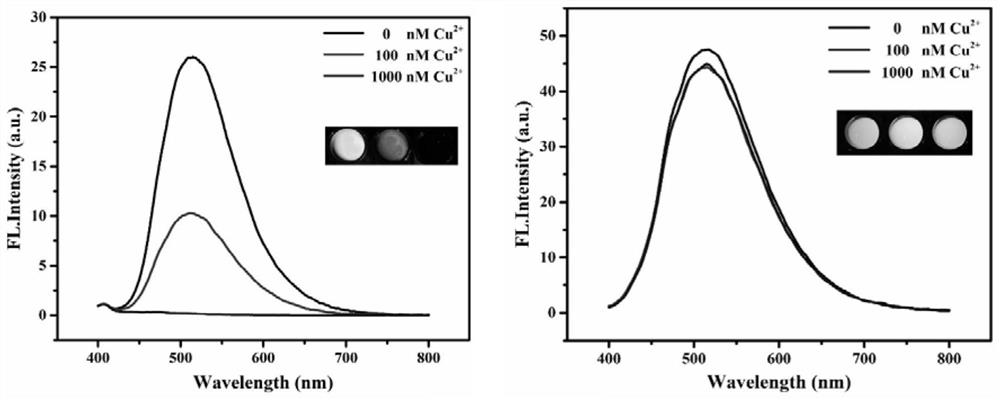Fluorescent probe for detecting copper ions as well as preparation method, detection method and application of fluorescent probe
A fluorescent probe, copper ion technology, applied in the fields of chemical analysis and environmental safety detection, can solve the problems of increased burden on the liver and kidneys, insufficient fluorescence quantum yield, poor metal ion selectivity, etc., and achieves good visual fluorescence change effect, High selectivity and sensitivity, strong photostability effect
- Summary
- Abstract
- Description
- Claims
- Application Information
AI Technical Summary
Problems solved by technology
Method used
Image
Examples
Embodiment 1
[0018] Embodiment 1: the preparation of fluorescent probe
[0019] 1. Preparation of 1,1,2,2-tetra-(4-carboxy-(1,1-biphenyl))ethylene solution
[0020] Weigh 40mg of 1,1,2,2-tetrakis-(4-carboxy-(1,1-biphenyl))ethylene and dissolve it in 40mL of 0.01M NaOH, repeatedly ultrasonically vortex until completely dissolved, and prepare 1mg / mL The solution.
[0021] Second, the preparation of polyethyleneimine solution
[0022] Weigh 500 mg of polyethyleneimine and dissolve it in 5 mL of ultrapure water, vortex repeatedly until it is completely dissolved, prepare a polyethyleneimine concentration of 100 mg / mL, and dilute to a series of concentrations with ultrapure water.
[0023] 3. Synthesis of fluorescent probes
[0024] Its reaction process is as figure 1 As shown, specifically: Add 1mL of 1,1,2,2-tetrakis-(4-carboxy-(1,1-biphenyl))ethylene solution to 0.9mL ultrapure water, mix well, add to the above solution 0.1 mL of polyethyleneimine solution was added to the solution, sti...
Embodiment 2
[0031] Example 2: Determination of fluorescent probes and 1,1,2,2-tetra-(4-carboxy-(1,1-biphenyl))ethylene in different Cu 2+ Fluorescence emission spectra in concentrations
[0032] Prepare three concentrations of Cu 2+ solution (0, 100 and 1000nM), add 20μL fluorescent probe prepared in Example 1 and 1,1,2,2-tetrakis-(4-carboxy-(1,1-biphenyl))ethylene solution to 300μL Tris Kind of Cu 2+ concentration of the solution, the excitation light is 360nm, and the emission is at 400-800nm. The result is as image 3 As shown, at room temperature, in different Cu 2+ Concentration, the left picture is the emission spectrum of the fluorescent probe, it can be seen that Cu at different concentrations 2+ Concentration, the fluorescence intensity of the fluorescent probe has an obvious response, and the illustration (physical photo) can also be clearly seen that with Cu 2+ As the concentration increases, the fluorescence in the enzyme-labeled wells is significantly quenched; Cu 2+ ...
Embodiment 3
[0033] Embodiment 3: Application of fluorescent probe to draw standard curve for determination of Cu 2+
[0034] Prepare a series of concentrations of Cu 2+ solution (0, 5, 10, 25, 50, 100, 250 and 500nM), take 20 μL of the fluorescent probe prepared in Example 1 and add 300 μL of different Cu 2+ Concentration, by measuring the fluorescence signal, the fluorescence response map (such as Figure 4 shown on the left) and the standard curve (such as Figure 4 shown on the right), the ordinate in the figure is the difference of fluorescence intensity, and the abscissa is Cu 2+ Concentration, the inset is the physical map; it can be found that with Cu 2+ As the concentration increases, the fluorescent signal in the enzyme-labeled wells gradually weakens.
PUM
| Property | Measurement | Unit |
|---|---|---|
| diameter | aaaaa | aaaaa |
| refractive index | aaaaa | aaaaa |
Abstract
Description
Claims
Application Information
 Login to View More
Login to View More - R&D
- Intellectual Property
- Life Sciences
- Materials
- Tech Scout
- Unparalleled Data Quality
- Higher Quality Content
- 60% Fewer Hallucinations
Browse by: Latest US Patents, China's latest patents, Technical Efficacy Thesaurus, Application Domain, Technology Topic, Popular Technical Reports.
© 2025 PatSnap. All rights reserved.Legal|Privacy policy|Modern Slavery Act Transparency Statement|Sitemap|About US| Contact US: help@patsnap.com



